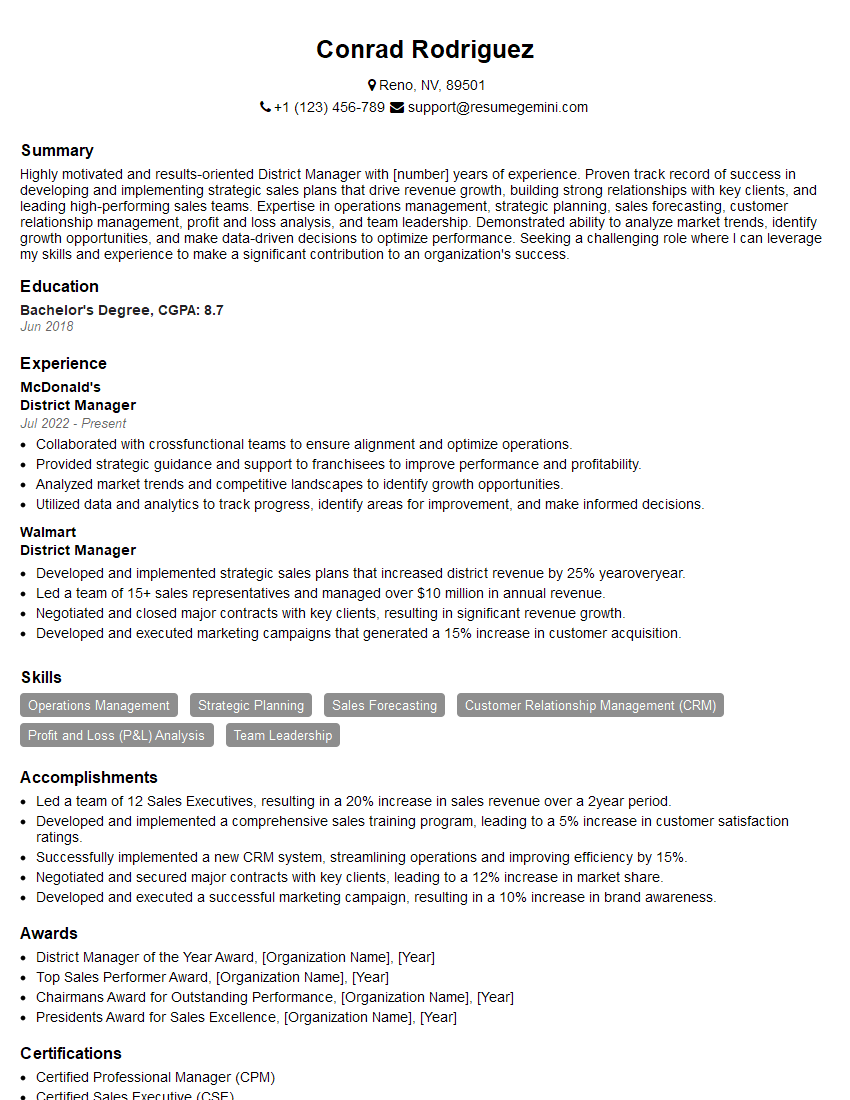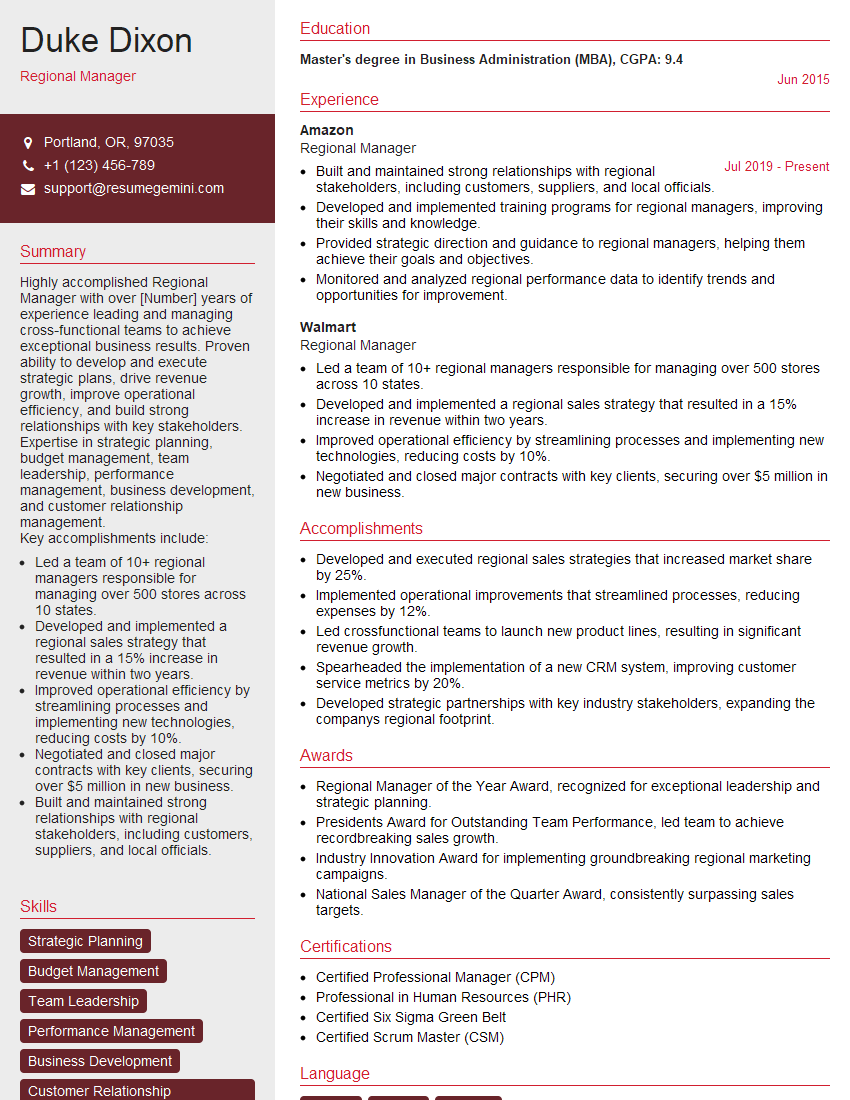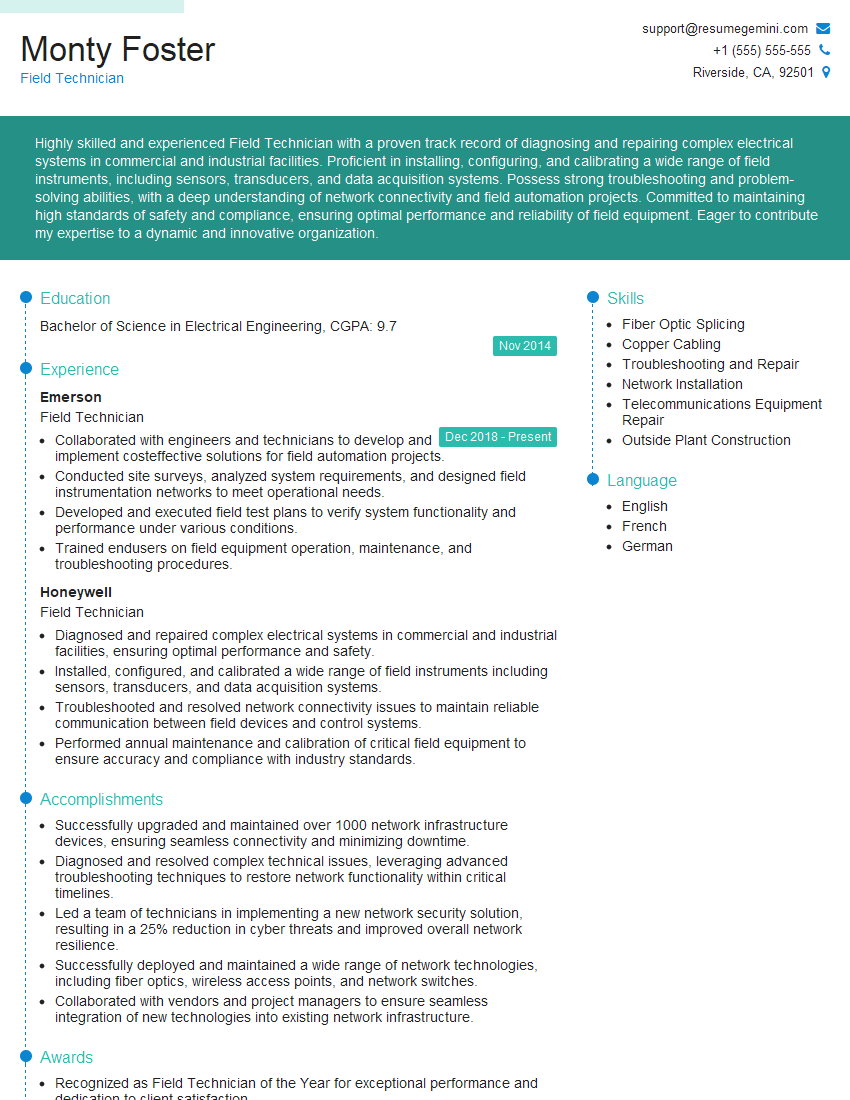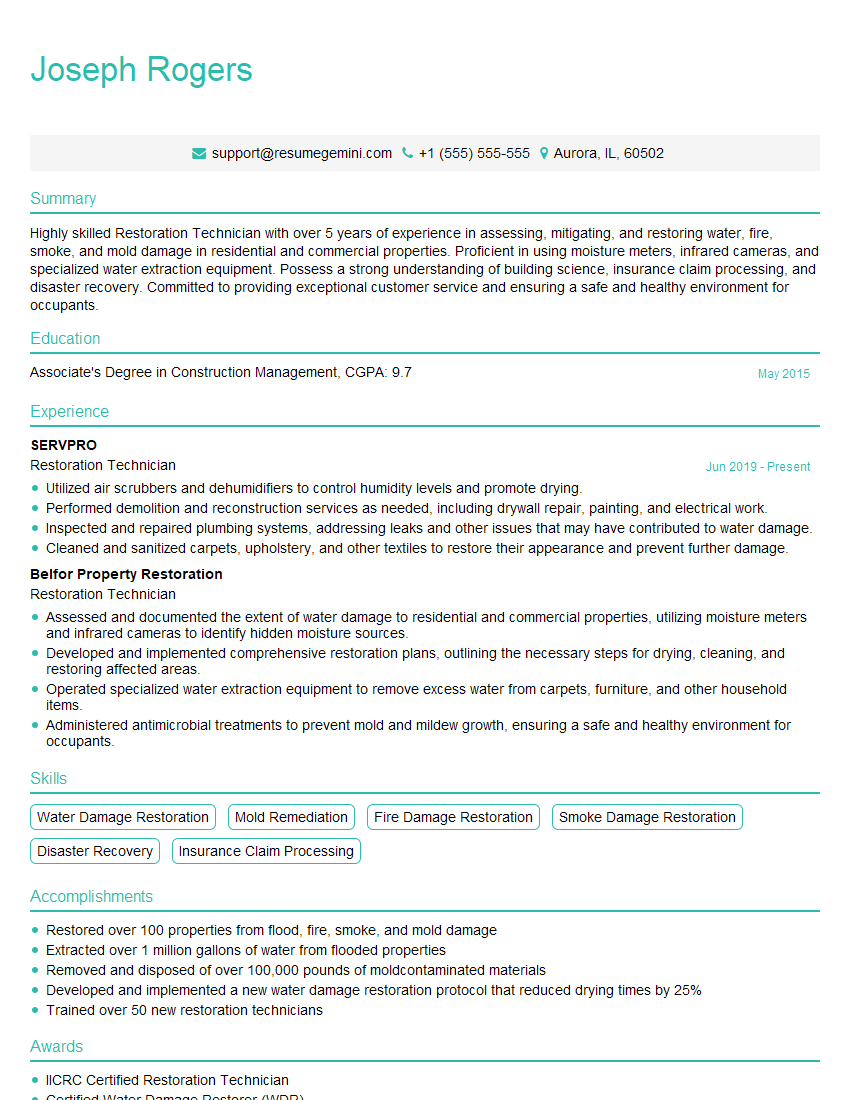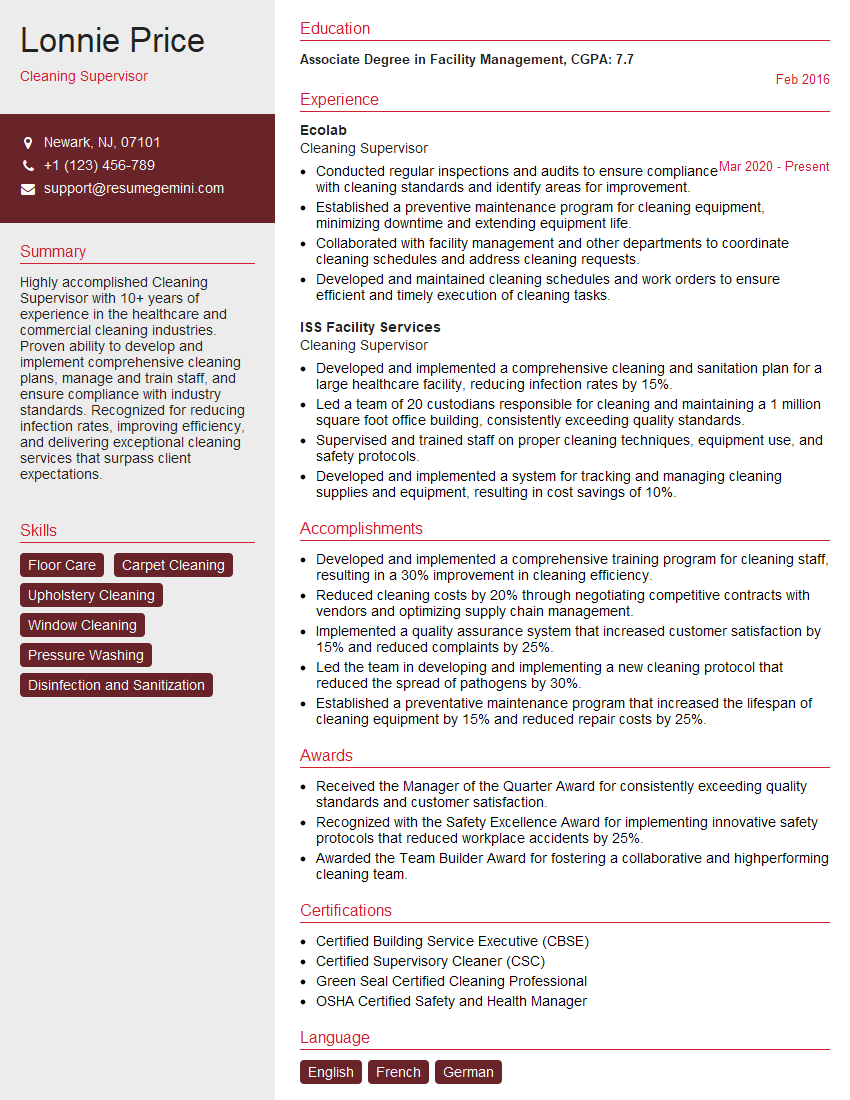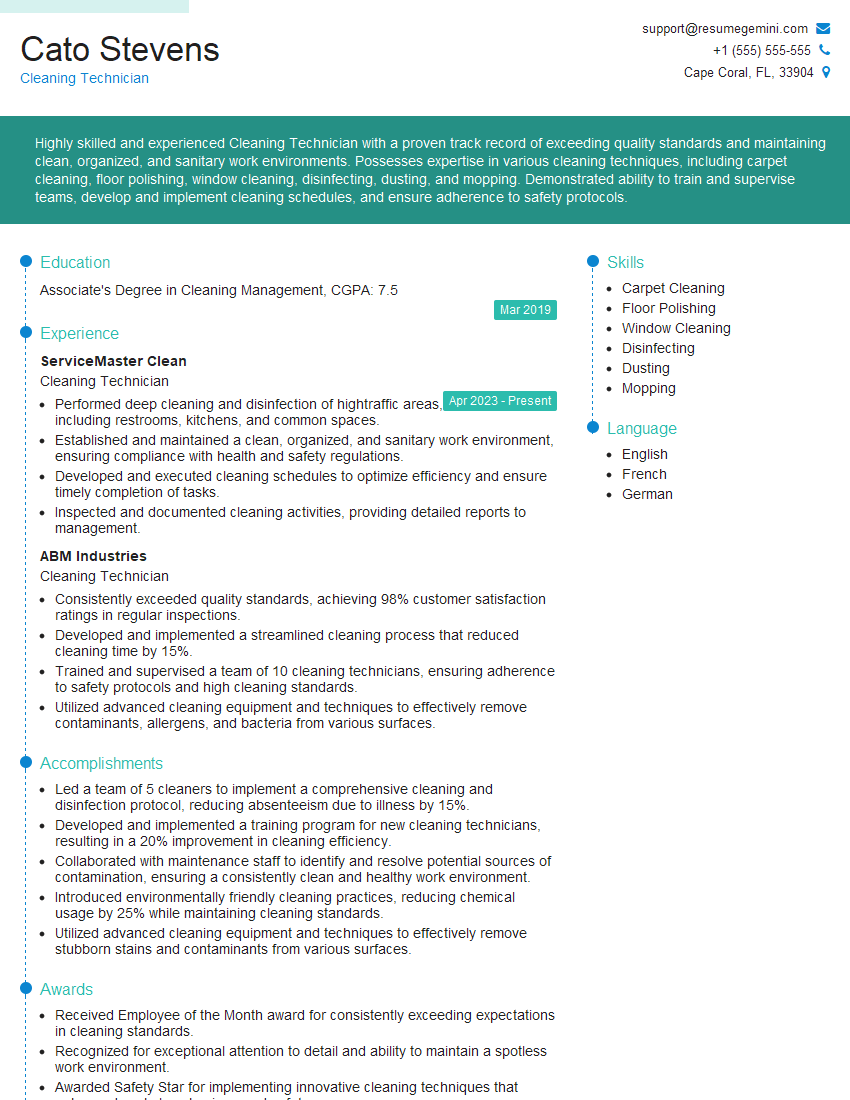Unlock your full potential by mastering the most common Rug and Upholstery Cleaning interview questions. This blog offers a deep dive into the critical topics, ensuring you’re not only prepared to answer but to excel. With these insights, you’ll approach your interview with clarity and confidence.
Questions Asked in Rug and Upholstery Cleaning Interview
Q 1. What are the different types of cleaning solutions used for rugs and upholstery?
Cleaning solutions for rugs and upholstery vary greatly depending on the material, the type of soiling, and the desired outcome. We use a tiered approach, starting with the gentlest methods possible.
- Water-based solutions: These are ideal for everyday cleaning and many delicate fabrics. They often include surfactants (to loosen dirt), and sometimes enzymes (to break down organic stains like pet accidents). We might adjust the pH to be slightly alkaline or acidic depending on the stain.
- Solvent-based solutions: These are more powerful and are reserved for tougher stains that water-based solutions can’t tackle. They are usually petroleum-based or citrus-based and require careful handling due to flammability concerns and potential damage to certain fibers. We always test these in an inconspicuous area first.
- Specialized stain removers: These address specific stains like red wine, oil, or ink. Each remover is formulated for a particular stain type and material. For example, we might use an oxygen-based bleach for colorfast fabrics, but never on delicate materials.
- pH-neutral cleaners: These maintain the natural balance of the fibers, preventing damage or discoloration. They are frequently used on delicate fabrics and wool rugs.
The choice of solution is always made after a thorough inspection of the rug or upholstery, taking into account the material composition, colorfastness, and the nature of the soiling.
Q 2. Explain the process of pre-cleaning inspection for rugs and upholstery.
The pre-cleaning inspection is paramount. It’s like a detective’s investigation before we even think about touching a cleaning solution. We thoroughly examine the rug or upholstery piece to:
- Identify the fiber type: This dictates the cleaning method. Wool requires a different approach than nylon, for instance.
- Assess the colorfastness: We perform a colorfastness test by applying a small amount of cleaning solution to an inconspicuous area. This prevents unexpected color bleeding during cleaning.
- Note existing damage: We look for fraying, tears, or previous damage to inform our cleaning strategy and prevent further harm. For instance, a weakened area might need extra care to avoid spreading.
- Document the staining: We meticulously record the location, type, and age of stains. This helps guide the cleaning process and sets realistic expectations. A ten-year-old red wine stain might not be completely removable.
- Check the backing: For rugs, we inspect the backing for deterioration, which can be a critical safety concern during cleaning.
This detailed inspection informs our cleaning plan and ensures we use the right tools and solutions for optimal results without causing further damage. It’s a crucial step we never skip!
Q 3. Describe your experience with various upholstery fabrics and their cleaning requirements.
My experience encompasses a wide range of upholstery fabrics, each with unique cleaning challenges:
- Cotton: Relatively durable and easy to clean; responds well to water-based solutions.
- Wool: Delicate and prone to shrinking; needs specialized cleaning methods and pH-neutral solutions.
- Silk: Extremely delicate; requires professional dry cleaning methods.
- Velvet: Requires careful cleaning to avoid crushing the pile; often needs specialized tools and techniques.
- Leather: Requires specific leather cleaners; needs conditioning after cleaning.
- Synthetic Fabrics (e.g., polyester, nylon): Generally durable and can tolerate more aggressive cleaning, although colorfastness must still be tested.
For example, I once worked on an antique velvet sofa with intricate embroidery. The client was understandably apprehensive. Through careful pre-inspection, delicate cleaning, and appropriate tools, I successfully restored it to its former glory without causing any damage.
Q 4. How do you identify and treat common stains on rugs and upholstery?
Stain identification is key. It’s not just about seeing a stain; it’s about understanding its composition. We use a systematic approach:
- Visual Inspection: Determining the stain’s color, texture, and age provides clues.
- Touch Test (Careful!): A gentle touch can indicate whether the stain is wet or dry, oily or watery.
- Test Cleaning: We apply a small amount of cleaning solution to an inconspicuous area to test its effectiveness and potential for color bleeding.
Treatment varies greatly depending on the stain:
- Water-based stains (e.g., coffee, juice): Often removed with water-based solutions and blotted gently.
- Oily stains (e.g., grease, oil): Require a solvent-based cleaner and may necessitate professional dry cleaning.
- Organic stains (e.g., pet urine, blood): Need enzyme-based cleaners to break down the organic matter.
- Ink stains: Can be tricky and may require specialized stain removers or even professional restoration.
Each stain requires a tailored approach; a ‘one-size-fits-all’ solution rarely works effectively and can cause damage.
Q 5. What safety precautions do you take when using cleaning chemicals?
Safety is paramount. We always prioritize the safety of both ourselves and the client’s property. Our precautions include:
- Proper Ventilation: Working in well-ventilated areas minimizes exposure to fumes from cleaning solutions.
- Protective Gear: We wear gloves, eye protection, and sometimes respirators, depending on the chemicals used.
- Safe Handling of Chemicals: We carefully follow the manufacturer’s instructions for each cleaning solution, including dilution ratios and application methods. We never mix different cleaning solutions, as this can create hazardous fumes.
- Proper Disposal: We dispose of cleaning solutions and waste materials according to local regulations.
- Child and Pet Safety: We ensure that the area is safe for children and pets before, during, and after the cleaning process.
Safety is non-negotiable; it’s ingrained in our work practices.
Q 6. How do you determine the appropriate cleaning method for different rug materials (e.g., wool, silk, synthetic)?
The cleaning method is entirely dependent on the rug’s material:
- Wool rugs: Often require professional dry cleaning or specialized water-based cleaning solutions. Harsh chemicals can damage the fibers and cause shrinkage.
- Silk rugs: Extremely delicate and typically require professional dry cleaning by experienced specialists. Water can cause irreparable damage.
- Synthetic rugs (nylon, polypropylene): Generally more durable and can tolerate more aggressive cleaning methods, including steam cleaning. However, always test colorfastness first!
- Cotton rugs: Can typically handle water-based cleaning methods.
For instance, a hand-knotted wool rug needs a gentle hand, whereas a machine-made polypropylene rug can withstand a more thorough cleaning. We never guess; we always identify the material first.
Q 7. What are the signs of rug and upholstery damage that require professional restoration?
Several signs indicate the need for professional restoration:
- Significant damage to fibers: Severe fraying, rips, or tears require expert repair.
- Severe discoloration: Stains that resist standard cleaning methods may indicate deep-seated damage.
- Moth or insect damage: Extensive damage from insects can only be addressed through professional restoration techniques.
- Water damage: Significant water damage can lead to mold growth or structural weakening, demanding professional intervention.
- Fading or color bleeding: Irreversible color loss or bleeding often requires specialized treatments.
We always assess the extent of damage during the pre-cleaning inspection. If the damage is beyond our cleaning capabilities, we refer the client to a specialized rug or upholstery restoration professional. It’s about knowing our limitations and providing the best possible outcome for the client.
Q 8. How do you handle customer complaints regarding cleaning results?
Handling customer complaints is crucial for maintaining a positive reputation. My approach is always to listen empathetically, acknowledging their concerns without interruption. I then thoroughly investigate the issue, reviewing the cleaning process and the specific challenges involved – was it a particularly stubborn stain, an unexpected fabric reaction, or perhaps a miscommunication about expectations? Once I understand the root cause, I offer a solution, whether it’s a re-cleaning, a partial refund, or a detailed explanation of why the result may not have met their initial expectations. Transparency is key; I aim to educate the customer about the realities of stain removal and the limitations of cleaning various materials. For example, I’d explain that some deeply ingrained dyes might not fully disappear, even with professional cleaning. Finally, I follow up to ensure their satisfaction and to learn from the experience, constantly refining my techniques and communication to prevent similar issues in the future.
Q 9. Explain the process of drying rugs and upholstery after cleaning.
Drying rugs and upholstery correctly is critical to prevent mold and mildew growth and to ensure the fabric doesn’t become damaged. The method depends on the material and the cleaning method used. For rugs cleaned with hot water extraction (steam cleaning), I use high-powered air movers to accelerate evaporation. These fans are positioned strategically to maximize airflow around the rug, and I monitor the progress regularly. For delicate rugs, I might opt for a more gentle approach, perhaps using absorbent pads to wick away excess moisture. With upholstery, I use air movers as well, but also carefully adjust the airflow to avoid over-drying which can lead to cracking. For thicker upholstery, I might employ strategically placed dehumidifiers to control moisture. Throughout the entire process, I monitor the moisture levels using a moisture meter to ensure thorough and safe drying.
Think of it like drying clothes: a delicate silk blouse needs a different approach than a thick cotton towel. Similarly, each rug or upholstery piece necessitates a tailored drying plan.
Q 10. What equipment and tools are essential for effective rug and upholstery cleaning?
Effective rug and upholstery cleaning requires a combination of specialized equipment and tools. Essential items include a powerful hot water extraction machine (a truck-mounted unit is ideal for larger jobs), a variety of cleaning solutions tailored to different fabrics and stains, various brushes (soft bristle, stiff bristle, and specialized tools for delicate fabrics), a wet vacuum to extract dirty water, air movers for rapid drying, protective sheeting to shield surfaces, and finally, a moisture meter to precisely check the drying level of the fabrics. Beyond these, having a good quality upholstery cleaning tool, like a hand-tool with different attachments, allows for effective cleaning of crevices and hard-to-reach areas. Finally, appropriate personal protective equipment (PPE), including gloves and safety glasses, is essential for protecting both the technician and the client’s property.
Q 11. Describe your experience with different types of cleaning equipment (e.g., hot water extraction, dry cleaning)?
I have extensive experience with both hot water extraction (steam cleaning) and dry cleaning methods. Hot water extraction is highly effective for removing deep-seated dirt and grime from many fabrics, but it’s crucial to use the correct temperature and pressure to avoid damage. Dry cleaning, using specialized solvents, is gentler and best suited for delicate materials such as silk or wool, where water-based cleaning might cause shrinkage or discoloration. I’ve found that a combination of both methods, depending on the fabric and the level of soiling, often yields the best results. For example, a heavily soiled wool rug might benefit from a pre-treatment with a dry cleaning solvent followed by a light hot water extraction to rinse. My experience allows me to choose the optimal approach for each unique cleaning challenge. Selecting the wrong method can seriously damage expensive items, hence the expertise is essential.
Q 12. How do you maintain and care for cleaning equipment?
Maintaining cleaning equipment is paramount for its longevity and to ensure consistent cleaning performance. After each use, I thoroughly rinse all hoses and attachments of the hot water extraction machine to prevent clogging and buildup of cleaning solutions. The machine itself is inspected for any leaks or damage. I regularly check and replace the filters to maintain suction power. For dry cleaning equipment, I follow the manufacturer’s instructions for cleaning and maintaining the solvent tanks and filters. Regular servicing by qualified technicians is also scheduled to prevent costly repairs and ensure optimal performance. Tools such as brushes are regularly cleaned and disinfected to prevent cross-contamination. Proper storage is also vital to prevent damage and prolong the lifespan of all my equipment.
Q 13. What is your experience with spot cleaning vs. overall cleaning?
Spot cleaning addresses individual stains or soiled areas, while overall cleaning tackles the entire surface. Spot cleaning is ideal for quick fixes of minor spills or blemishes, while overall cleaning is necessary for a comprehensive deep clean. The choice depends on the situation. A spilled glass of red wine calls for immediate spot cleaning, while an aging rug or heavily soiled sofa needs thorough overall cleaning. I often combine both approaches: for instance, I might spot clean stubborn stains before proceeding with an overall hot water extraction to refresh the entire piece. My expertise lies in identifying when each approach, or a combination, is most appropriate. Understanding the type of stain and the fabric’s properties is key in deciding the best cleaning strategy.
Q 14. How do you handle delicate fabrics like silk or velvet?
Delicate fabrics like silk and velvet require a highly specialized approach. I use only gentle, pH-neutral cleaning solutions specifically formulated for these materials. I avoid harsh scrubbing or excessive brushing which can damage the delicate fibers. I often opt for dry cleaning methods, employing specialized solvents and techniques to lift the dirt without causing damage. In some cases, I might use a low-moisture cleaning method, applying a small amount of solution followed by a very gentle extraction with absorbent cloths. Each fabric has specific characteristics that determine the best cleaning approach. For example, silk is highly sensitive to water, while velvet can be susceptible to crushing. Careful pre-testing on a hidden area is essential before proceeding with the cleaning to ensure the chosen method won’t cause any discoloration or damage. My experience allows me to adapt my technique and choose the right tools to protect these precious items.
Q 15. Describe your knowledge of different cleaning agents and their application.
Selecting the right cleaning agent is crucial for effective and safe rug and upholstery cleaning. My knowledge encompasses a wide range of products, categorized by their chemical composition and intended use.
- Water-based solutions: These are generally safe for most fabrics and are effective for removing everyday dirt and grime. I often use pH-neutral cleaners to avoid damaging delicate fibers. For tougher stains, I might incorporate enzymes to break down organic matter.
- Solvent-based solutions: These are powerful cleaners used sparingly, typically for oil-based stains like grease or ink. They require careful application and thorough rinsing to avoid residue buildup. Safety precautions, including proper ventilation, are paramount when using solvents.
- Specialty cleaning agents: This category includes products designed for specific stains or materials. For example, I use specific agents for pet stains, wine stains, or for cleaning delicate fabrics like silk or wool. Each agent requires a specific application technique and safety protocol.
The application method depends on the type of stain, fabric, and cleaning agent. For example, applying a cleaning agent directly to a stain might damage a delicate fabric. Instead, I often pre-treat the stain by gently dabbing the solution, allowing it to penetrate before further cleaning.
Career Expert Tips:
- Ace those interviews! Prepare effectively by reviewing the Top 50 Most Common Interview Questions on ResumeGemini.
- Navigate your job search with confidence! Explore a wide range of Career Tips on ResumeGemini. Learn about common challenges and recommendations to overcome them.
- Craft the perfect resume! Master the Art of Resume Writing with ResumeGemini’s guide. Showcase your unique qualifications and achievements effectively.
- Don’t miss out on holiday savings! Build your dream resume with ResumeGemini’s ATS optimized templates.
Q 16. Explain the importance of proper ventilation during cleaning.
Proper ventilation is absolutely critical during rug and upholstery cleaning for several reasons. Firstly, many cleaning agents, particularly solvent-based ones, release volatile organic compounds (VOCs) that are harmful if inhaled. These VOCs can cause respiratory irritation, headaches, and in severe cases, more serious health issues. Secondly, adequate ventilation ensures that moisture evaporates quickly, preventing mold and mildew growth, which is a common problem in damp environments. Finally, it speeds up the drying process, leading to a faster turnaround time for the customer.
In practice, I always ensure that the area being cleaned is well-ventilated. This can involve opening windows, using fans, and even employing specialized air purifiers to remove lingering VOCs. The safety of both my clients and myself is my top priority.
Q 17. How do you ensure the proper disposal of cleaning waste?
Responsible disposal of cleaning waste is vital for environmental protection and public health. I strictly adhere to local regulations for waste disposal. This includes separating different types of waste, such as solid waste (e.g., used cloths, packaging) and liquid waste (e.g., wastewater from extraction).
- Solid waste: This is usually disposed of in designated waste bins according to local regulations. I often use biodegradable and recyclable materials whenever possible to minimize my environmental impact.
- Liquid waste: Wastewater containing cleaning agents needs special handling. I ensure that all wastewater is properly filtered and disposed of through designated channels, avoiding direct discharge into drains or water bodies. In some cases, this might involve using specialized filtration systems to remove residual cleaning chemicals.
Record-keeping is essential to ensure compliance. I maintain detailed records of all cleaning agents used and the disposal methods employed. This documentation is readily available in case of inspections or audits.
Q 18. Describe your experience with water extraction techniques.
Water extraction is a core technique in rug and upholstery cleaning. It involves removing excess moisture and cleaning solution from the fibers using specialized equipment. My experience encompasses various extraction methods:
- Hot water extraction (steam cleaning): This method uses high-pressure hot water to agitate and lift dirt and stains, then extracts the soiled water and cleaning solution using a powerful vacuum. It’s effective but requires careful monitoring to avoid over-wetting.
- Dry cleaning: This uses absorbent compounds rather than water to lift dirt. It’s ideal for delicate fabrics or when water damage needs to be minimized. The choice between these two depends largely on the material and its condition
Efficient water extraction is essential to prevent mold and mildew growth, and to minimize drying time. I use high-capacity extraction machines and follow specific procedures to ensure maximum moisture removal. Regular maintenance and calibration of the equipment are crucial for optimal performance.
Q 19. How do you protect floors and furniture during cleaning?
Protecting floors and furniture during cleaning is crucial to prevent damage and ensure client satisfaction. My approach is multifaceted:
- Floor protection: I use drop cloths or plastic sheeting to cover the floors before starting any cleaning process. This prevents spills and protects delicate floor surfaces.
- Furniture protection: Furniture is covered with protective cloths or plastic covers to prevent soiling or damage from cleaning solutions or equipment. Fragile items are removed from the area entirely.
- Furniture pads: When using heavy equipment like extraction machines, I place protective pads under the machine’s legs to prevent scratches or indentations on wood or other delicate surfaces.
Careful preparation is key. Before beginning, I carefully inspect the area to identify any potential risks and take appropriate protective measures. This diligent preparation saves time and avoids potential problems.
Q 20. What are the common challenges you face in rug and upholstery cleaning?
Rug and upholstery cleaning presents several common challenges:
- Tough stains: Removing deeply embedded or stubborn stains, such as pet urine, red wine, or ink, can be quite challenging and often requires multiple treatment techniques.
- Delicate fabrics: Cleaning delicate materials like silk, wool, or antique rugs necessitates a gentle approach to avoid damage to the fibers. The cleaning process often must be adapted based on the materials’ specific requirements.
- Color bleeding: Some dyes can bleed when exposed to moisture and cleaning agents. Proper testing and careful application are needed to avoid color damage.
- Water damage: Over-wetting during cleaning can lead to mold and mildew growth or damage the structure of the rug or upholstery. Careful moisture control is vital to avoid this.
Overcoming these challenges requires a combination of knowledge, experience, and the right tools. Careful pre-inspection, appropriate cleaning agent selection, and controlled water extraction are key elements in my approach.
Q 21. How do you adapt your cleaning approach based on different customer requirements?
Adaptability is key in this profession. I tailor my cleaning approach to each customer’s specific requirements. This involves:
- Understanding client preferences: I discuss their expectations and concerns regarding the cleaning process, including preferred cleaning methods, drying timeframes, and budget constraints.
- Assessing fabric type and condition: A pre-cleaning inspection helps determine the appropriate cleaning method, agents, and equipment to ensure optimal results without damaging the fabric.
- Addressing specific concerns: Customers may have particular concerns, such as pet stains, allergies, or the presence of valuable artifacts. I adapt my procedures to address these issues effectively.
- Offering different service packages: I provide different service options to cater to various budgets and needs, ranging from basic cleaning to specialized treatments for antique items or severely soiled materials.
For example, a customer with allergies might require a thorough rinsing and drying process to minimize residue. A client with an antique rug might opt for a more gentle dry cleaning method. By understanding and responding to their needs, I ensure customer satisfaction and build trust.
Q 22. How do you handle unexpected issues during a cleaning job?
Unexpected issues are part and parcel of rug and upholstery cleaning. My approach is always proactive and methodical. First, I assess the situation calmly. For example, if I discover a hidden stain that wasn’t mentioned, I immediately communicate this to the client, explaining the potential impact on the cleaning process and the final outcome. We discuss options – whether to proceed with adjusted pricing or reschedule. If it’s a minor issue, like a small, previously unseen tear, I might offer a simple repair as part of the service, if I’m capable. However, if the issue is beyond my expertise, I’ll recommend a specialist, like a textile conservator for antique rugs. Transparency and clear communication are key to resolving these unexpected challenges smoothly.
Another common unexpected issue is the type of fabric. Sometimes a client believes they know the material, but it turns out to be different, requiring a change in cleaning technique to avoid damage. For example, I might encounter a rug labeled as wool, which is actually a blend, requiring more careful treatment to avoid shrinkage or color bleeding. In these situations, I use my extensive knowledge of different fibers to quickly adapt my approach and always prioritize the safety of the item. Ultimately, my goal is always client satisfaction and protecting their investment.
Q 23. How do you maintain a high standard of cleanliness and hygiene during cleaning?
Maintaining a high standard of cleanliness and hygiene is paramount. This begins before I even enter a client’s home. I use clean, well-maintained equipment, and always wear fresh protective gear – gloves, apron, and shoe covers. I use specialized cleaning solutions that are safe for both the items being cleaned and the environment, and are tested to be hypoallergenic and eco-friendly. My cleaning process includes meticulous pre-vacuuming to remove loose dirt and debris, followed by specific cleaning methods tailored to the rug or upholstery material. After cleaning, I always rinse thoroughly to prevent residue build-up. Finally, I ensure the area is completely dried before leaving, using appropriate air circulation or specialized drying equipment. I also ensure that all my equipment is thoroughly cleaned and disinfected after each job to maintain the highest level of hygiene. I even use separate equipment for different materials to avoid cross-contamination.
Q 24. How do you determine the pricing for your cleaning services?
Pricing is determined by several factors. The size and type of rug or upholstery are significant. A large, intricately designed Persian rug will naturally cost more than a small, simple area rug. The material of the item plays a large role, with delicate materials such as silk requiring more specialized and time-consuming processes. The level of soiling also affects the price; heavily soiled items will need more intensive cleaning, increasing the cost. Finally, any additional services required – like stain removal, odor treatment, or minor repairs – will be added to the overall price. I provide clients with a transparent and detailed quote before starting any work. I believe in offering fair and competitive pricing while ensuring that my work is of the highest quality.
For example, a small cotton rug might cost significantly less to clean than a large wool rug with embedded stains. This system makes pricing transparent and fair for all our clients.
Q 25. Describe your experience with scheduling and managing cleaning jobs.
Scheduling and managing cleaning jobs efficiently is crucial for my business. I use a scheduling software that allows clients to book appointments online, ensuring a streamlined process. The software sends automated reminders, minimizing missed appointments and reducing administrative overhead. I maintain a detailed calendar with all appointments, noting the type of service, client contact information, and any special instructions. This organization helps prevent conflicts and ensures I’m always on schedule. When faced with an unexpected delay, I immediately inform the affected clients and explore rescheduling options. Maintaining this system allows me to provide high-quality service in a timely manner, reducing stress for myself and the clients.
Q 26. What are your communication skills like, particularly with clients?
Communication is the cornerstone of my business. I strive to maintain open and transparent communication with clients from the initial contact to the completion of the service. I actively listen to their concerns, answer all questions patiently and thoroughly, and provide regular updates on the progress of their cleaning job. I use clear and simple language to avoid any misunderstandings and ensure clients are well-informed about the process. Before starting any cleaning, I always discuss the approach I plan to take, any potential risks, and the expected results. For instance, I always confirm the cleaning method and explain the drying time before I start the procedure. I am also responsive to follow-up communications, addressing any post-cleaning questions or concerns promptly. Positive feedback from my clients shows that my communication is effective and builds trust.
Q 27. How do you stay updated on the latest cleaning techniques and technologies?
Staying updated on the latest cleaning techniques and technologies is essential in this field. I regularly attend industry conferences and workshops to learn about new cleaning products, methods, and equipment. I subscribe to trade publications and online resources to keep abreast of the latest developments. I also actively engage with other professionals in the field, sharing knowledge and best practices. For example, I recently attended a workshop on using enzyme-based cleaning solutions for delicate fabrics. Learning this technique allowed me to improve stain removal effectiveness and enhance my services. Continuous learning ensures I offer clients the most effective and up-to-date cleaning services while maintaining a high standard of expertise.
Q 28. Describe your problem-solving approach in a challenging cleaning situation.
My problem-solving approach involves a systematic process. First, I carefully assess the situation, identifying the root cause of the problem. For instance, if I encounter a stubborn stain that resists initial cleaning attempts, I carefully determine the stain’s type and age before selecting an appropriate cleaning method. This might involve researching different stain removal techniques based on fiber type and stain composition. Next, I develop a plan of action, testing different solutions or techniques on an inconspicuous area to avoid damaging the material. I always prioritize the safety of the material, opting for gentler methods if necessary. I document each step, taking notes and photos for reference. If a problem proves particularly challenging, I consult with other experts in the field for advice before taking further action. Finally, I evaluate the results and adjust my approach if needed. This meticulous approach, coupled with a willingness to seek out help when needed, ensures that I effectively resolve even the most challenging cleaning situations.
Key Topics to Learn for Rug and Upholstery Cleaning Interview
- Understanding Fiber Types: Learn to identify different fiber types (wool, silk, cotton, synthetic) and their cleaning requirements. This includes understanding the impact of water, cleaning solutions, and drying methods on various materials.
- Stain Removal Techniques: Master various stain removal techniques, from pre-treating stains to employing appropriate cleaning solutions and tools. This includes understanding the chemistry behind stain removal and the importance of testing solutions in inconspicuous areas.
- Cleaning Methods & Equipment: Familiarize yourself with various cleaning methods (dry cleaning, wet cleaning, steam cleaning) and the equipment used for each. Understand the pros and cons of each method and when to apply them based on fabric type and stain.
- Pre-Inspection & Assessment: Develop the skill of thoroughly inspecting rugs and upholstery before cleaning. This involves identifying potential damage, determining the best cleaning approach, and communicating effectively with clients about expectations and limitations.
- Health & Safety Protocols: Understand and be able to articulate the safety precautions necessary when handling cleaning chemicals, operating equipment, and working in various environments (e.g., client homes). This includes proper disposal of waste materials.
- Post-Cleaning Care & Maintenance: Learn to advise clients on proper post-cleaning care and maintenance to prolong the life and appearance of their rugs and upholstery. This includes recommendations for spot cleaning and regular maintenance.
- Pricing & Estimating: Understand how to accurately estimate the cost of cleaning services based on factors like size, material, level of soiling, and required techniques.
- Customer Service & Communication: Develop strong customer service skills, including effective communication, problem-solving, and handling client concerns with professionalism and empathy.
Next Steps
Mastering rug and upholstery cleaning opens doors to a fulfilling and potentially lucrative career with opportunities for growth and specialization. A strong resume is key to unlocking these opportunities. Creating an ATS-friendly resume will significantly increase your chances of getting noticed by recruiters and securing interviews. ResumeGemini is a trusted resource that can help you build a professional and impactful resume. Examples of resumes tailored to the rug and upholstery cleaning industry are available to guide you.
Explore more articles
Users Rating of Our Blogs
Share Your Experience
We value your feedback! Please rate our content and share your thoughts (optional).
What Readers Say About Our Blog
Hello,
We found issues with your domain’s email setup that may be sending your messages to spam or blocking them completely. InboxShield Mini shows you how to fix it in minutes — no tech skills required.
Scan your domain now for details: https://inboxshield-mini.com/
— Adam @ InboxShield Mini
Reply STOP to unsubscribe
Hi, are you owner of interviewgemini.com? What if I told you I could help you find extra time in your schedule, reconnect with leads you didn’t even realize you missed, and bring in more “I want to work with you” conversations, without increasing your ad spend or hiring a full-time employee?
All with a flexible, budget-friendly service that could easily pay for itself. Sounds good?
Would it be nice to jump on a quick 10-minute call so I can show you exactly how we make this work?
Best,
Hapei
Marketing Director
Hey, I know you’re the owner of interviewgemini.com. I’ll be quick.
Fundraising for your business is tough and time-consuming. We make it easier by guaranteeing two private investor meetings each month, for six months. No demos, no pitch events – just direct introductions to active investors matched to your startup.
If youR17;re raising, this could help you build real momentum. Want me to send more info?
Hi, I represent an SEO company that specialises in getting you AI citations and higher rankings on Google. I’d like to offer you a 100% free SEO audit for your website. Would you be interested?
Hi, I represent an SEO company that specialises in getting you AI citations and higher rankings on Google. I’d like to offer you a 100% free SEO audit for your website. Would you be interested?
good


